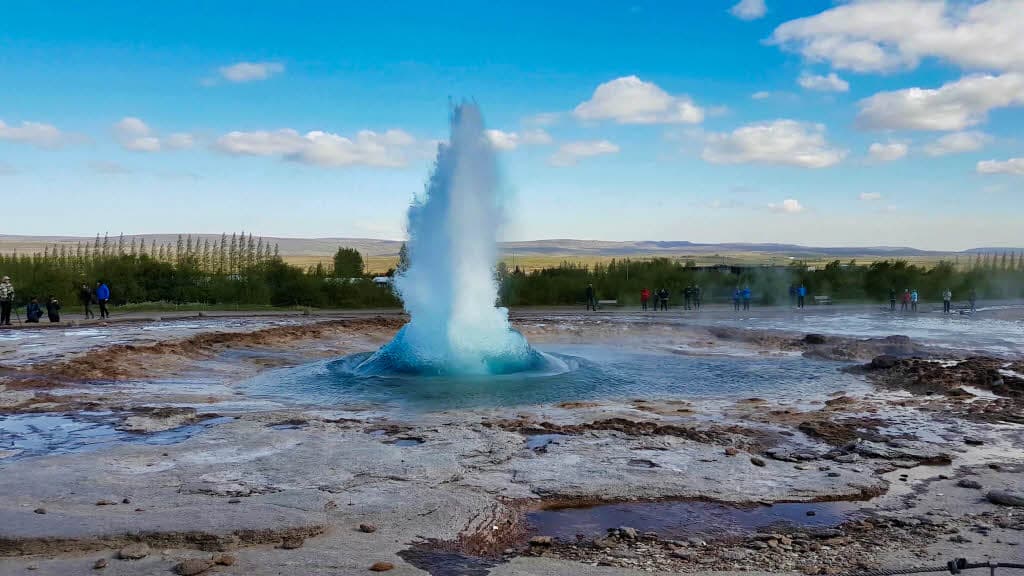Iceland, renowned for its stunning natural landscapes, hosts some of the most impressive geothermal phenomena on Earth. Among these, the Geysir and Strokkur geysers stand out as spectacular showcases of nature’s power.
Understanding Geysers: Nature’s Spectacular Performers
Geysers are extraordinary geological formations, essentially hot springs that episodically eject water and steam into the air. This activity results from intricate interactions between groundwater, geothermal heat, and subterranean volcanic elements, often found in regions of significant tectonic activity.
The Phenomenon of Geyser Eruption
The eruption of a geyser is a captivating process, necessitating a unique set of geological conditions. These include an ample source of groundwater to replenish the geyser’s reservoir, a substantial geothermal heat source to superheat the water, and specific structural features like cracks and fumaroles that facilitate the dramatic expulsion of steam and water.
A Spotlight on the World’s Prominent Geysers
Globally, several geysers have captured the imagination of visitors and scientists alike. Notable among them is Old Faithful in the United States, celebrated for its regular eruptions, and the Geysir and Strokkur geysers in Iceland, with Strokkur being particularly active, offering frequent and stunning displays.
The Majestic Great Geysir: A Historic Natural Wonder
The Great Geysir, revered as one of the largest and oldest known geysers, has a rich history of activity. Though its eruptions have become less frequent over time, it remains a symbol of the dynamic forces that shape our planet.
The Dynamic Strokkur Geyser: Iceland’s Geothermal Jewel
Strokkur, the most vibrant geyser in Iceland, erupts with remarkable regularity, sending jets of steam and water up to 40 meters into the sky. This geyser provides a breathtaking spectacle for visitors, epitomizing the raw beauty and power of Iceland’s geothermal activity.
Exploring Iceland’s Geysir Geothermal and Hot Springs Area
The Geysir geothermal area, a significant attraction in southeast Iceland, is a hotspot of geothermal activity. Here, visitors can witness the power of the Earth’s interior at work, with Strokkur’s eruptions being a highlight alongside bubbling mud pools, steam vents, and the distinctive scent of sulfur.
Comparative Table: The Great Geysir vs. Strokkur Geyser
| Feature | The Great Geysir | Strokkur Geyser |
|---|---|---|
| Location | Haukadalur Valley, Iceland | Haukadalur Valley, Iceland |
| Eruption Frequency | Infrequent, varies greatly | Every 4-10 minutes |
| Eruption Height | Up to 70 meters (230 feet) historically | Up to 40 meters (130 feet) |
| Temperature | Approximately 100°C at the surface | Around 100-120°C at the vent |
| Historical Significance | One of the first geysers in literature | Known for its reliability and accessibility |
| Activity Level | Currently less active | Highly active |
| Discovery | Known since the 13th century | Documented in the 18th century |
| Tourist Attraction | High due to historical value | High due to frequent and spectacular eruptions |
Features of Iceland’s Geysers: Bullet Points
- Geothermal Activity: Both geysers are situated in Iceland’s active geothermal area, showcasing the country’s vast geothermal energy;
- Eruption Mechanics: Geysers erupt due to the intense pressure of heated water underground, seeking release through vents to the surface;
- Cultural Significance: The Great Geysir has been a landmark since medieval times, embodying the power and mystery of nature in Icelandic culture;
- Environmental Conditions: The surrounding area is characterized by stunning landscapes, including hot springs, mud pots, and fumaroles, contributing to the unique geothermal ecosystem;
- Conservation Efforts: Efforts are in place to preserve these natural wonders while allowing for sustainable tourism, balancing visitor access with environmental protection;
- Educational Value: The geysers serve as natural laboratories, offering insights into geothermal processes, volcanic activity, and Earth’s internal heat mechanisms;
- Visitor Experience: Strokkur provides a more predictable and frequent eruption experience, making it a favorite for tourists seeking the thrill of witnessing a geyser eruption firsthand.
Video Guide
To answer all your questions, we have prepared a video for you. Enjoy watching it!
Conclusion
Iceland’s geothermal areas, particularly those housing the iconic Great Geysir and the dynamic Strokkur Geyser, stand as testaments to the Earth’s vibrant energy and geological diversity. These natural phenomena not only provide a window into the processes that shape our planet but also offer a unique opportunity for education, conservation, and sustainable tourism. The Great Geysir, with its historical significance and sporadic eruptions, reminds us of the enduring power lying dormant beneath the Earth’s crust, while the Strokkur Geyser, with its regular and spectacular displays, illustrates the constant activity and change inherent in our natural world.
Together, these geysers embody the spirit of Iceland’s landscape—wild, unpredictable, and profoundly beautiful. They invite us to reflect on the forces that have sculpted the Earth over millennia and the importance of preserving such wonders for future generations to marvel at and learn from. As we continue to explore and understand these geothermal marvels, we are reminded of our place within the broader context of Earth’s geological history and the need to tread lightly upon this magnificent planet that we call home.
In conclusion, the geysers of Iceland are not just natural attractions; they are symbols of the earth’s power, beauty, and resilience. They challenge us to appreciate the complexities of our planet and to engage with the natural world in ways that are both mindful and informed. As we stand in awe of the Great Geysir’s history and the Strokkur Geyser’s vitality, we are witnessing the incredible story of Earth itself, unfolding in steam and spray against the backdrop of Iceland’s stunning landscapes.



